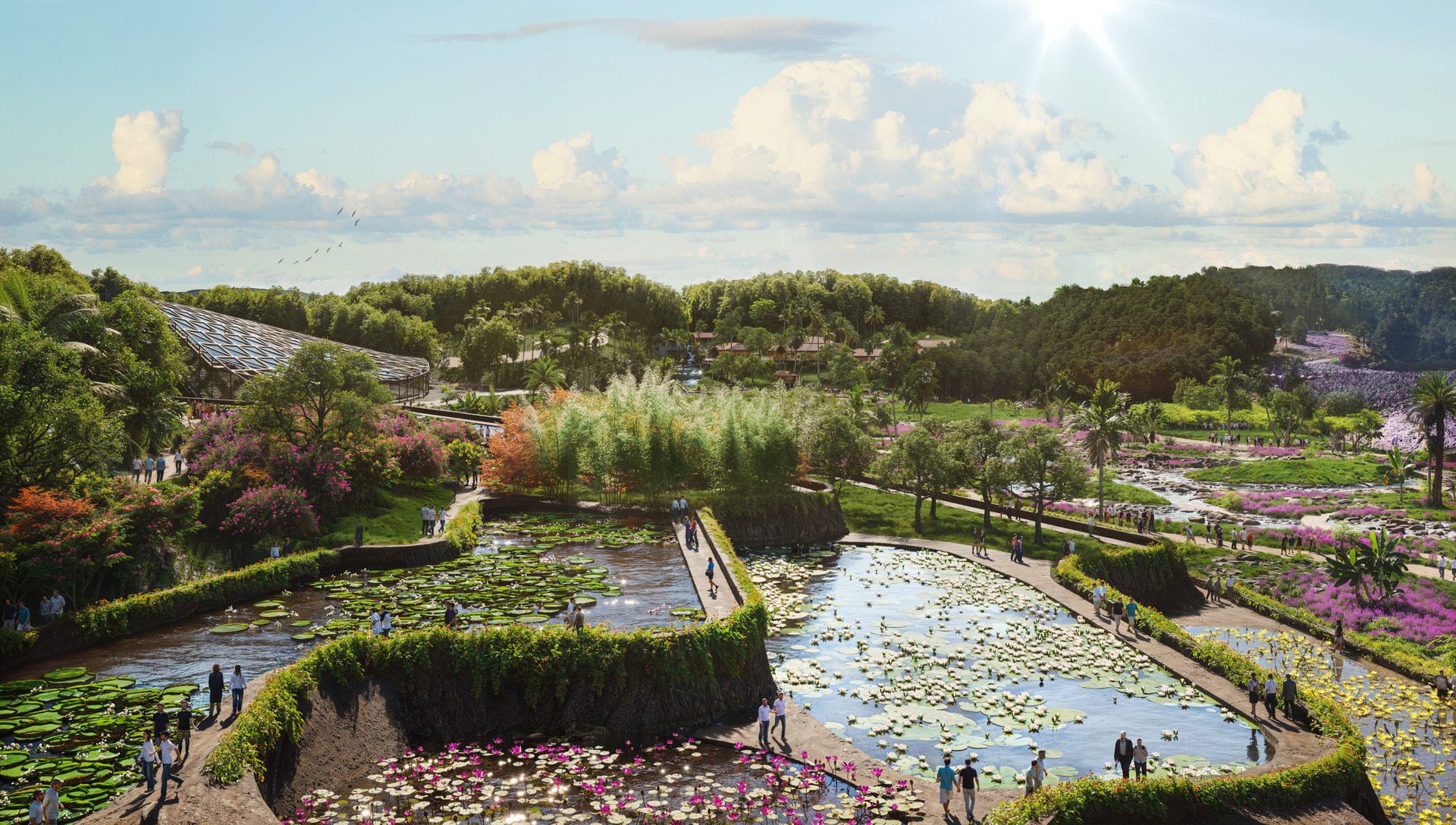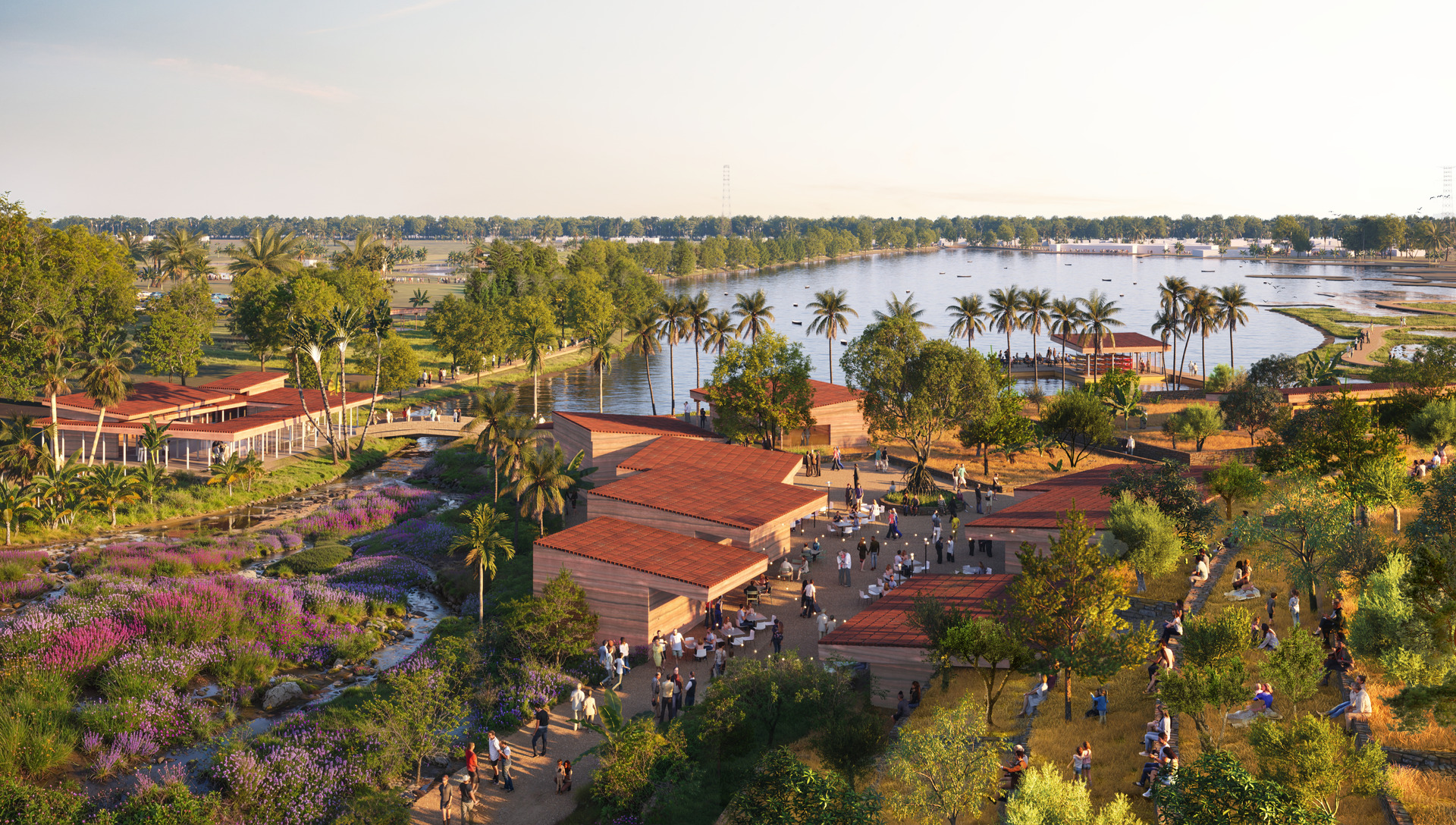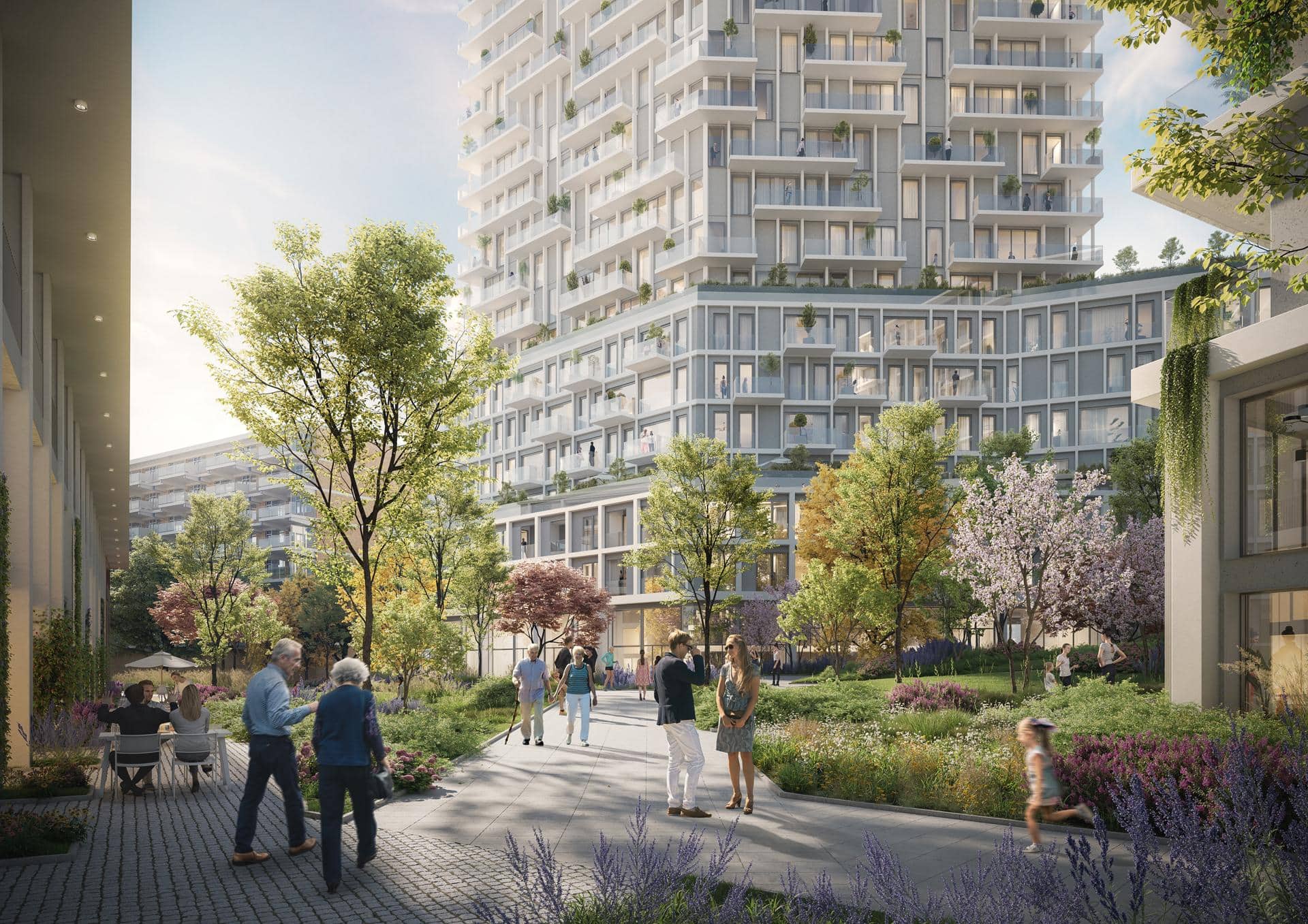Importance of Visualization in Landscape Architecture
Visualizing complex designs is crucial in landscape architecture. High-quality visualizations bridge the gap between designers and customers, simplifying the communication of intricate details of technical concepts. Imagine trying to explain a multi-layered garden plan with just words. It’s nearly impossible. But with the power of 3D pictures, clients can see detailed representations of outdoor spaces, aiding in their decision-making process and ensuring that everyone is on the same page.
#1 3D Landscape Visualization as Flaws Detector
Moreover, effective 3D landscape visualizations can identify potential planning issues early in the project development stage. Catching these problems early saves architects both time and resources, ensuring a smoother project flow. The use of custom models enhances the planning workflow by providing unique assets like trees, shrubs, perennials, and more. This allows for a more tailored approach to visualization and rendering project execution by a 3D visualization studio. The integration of storytelling in these visualizations also fosters emotional connections, making concepts more relatable and engaging for the audience.
#2 3D Visualization as a User-Friendly Presentation Tool
A comprehensive approach to visualizations includes accurately rendering both hardscape and softscape features. This holistic representation not only enhances the overall aesthetic but also ensures functionality and cohesiveness in the design. When future users can visualize the entirety of outdoor spaces, from the trees on the patio to the flower beds, they are more likely to invest in the project and be satisfied with the outcome.


Botanical garden master plan at Kadambur, near Maraimalai Nagar, Chengalpattu District, Tamilnadu, India / Urban designer: WEST8 / 3D aerial view renderings crafted by RNDR
Why High-Quality Visualizations are Essential for Winning Projects
In today’s competitive market, high-quality visualizations are a game-changer for landscape architects looking to win projects. Customers, investors, and stakeholders often struggle to interpret traditional blueprints or 2D plans, making it difficult to grasp the full potential of a design. Landscaping renderings bridge this gap by transforming technical concepts into easy-to-understand representations. These visuals not only enhance presentations but also build trust by showcasing the project’s feasibility, aesthetics, and functionality in precise detail. Additionally, high-quality renderings allow architects to highlight key design features, demonstrate environmental sustainability, and provide multiple design variations in simple steps, ultimately leading to faster approvals and stronger client engagement. By investing in top-tier visualization services, landscape designers can effectively communicate their vision, stand out from the competition, and significantly increase their chances of securing projects.
Effective 3D Visualization Techniques
Effective 3D visualization techniques are essential for communicating designs and bringing outdoor spaces to life. Here are some techniques used by 3D visualization studios to enhance landscape visualizations:
- Use High-Quality Images and Textures: Incorporate high-resolution images and textures to create realistic and detailed visualizations. This attention to detail can make your landscape designs more convincing and appealing.
- Play with Lighting and Shadows: Experiment with different lighting conditions and shadows to create depth and ambiance in visualizations. Proper lighting can highlight focal points with key design features and make the space feel more dynamic and lifelike.
- Incorporate 3D Models of Plants: Use 3D models of plant life like trees, shrubs, flowers, and grass to showcase intricate design parts in scale in order to create engaging visualizations. These incorporated objects can help understand how different greenery components will look, better than the schematic design.




Residential living at Vondel en Zwaan in Netherlands / Architect and landscape architect: FSD x Rijnboutt / 3D landscape design renderings provided by RNDR
Enhance Your Landscape Presentations
One of the most significant benefits of landscape visualization is its ability to enhance presentations. Even traditional technical drawings made by the best landscape design software or landscape design app can often be challenging to interpret for non-professionals, but 3D illustrations transform these designs into something much more accessible and engaging. Utilizing a 3D visualization library can turn a landscaping project into a more collaborative and personalized experience, ensuring that all client specifications are met for optimal results. These visual tools serve as vital communication and design process aids. They involve all stakeholders in the design process and ensure that everyone clearly understands the project.
High-quality visuals are essential in making client presentations more effective. They allow them visualize potential spaces as if they were already there, which significantly improves their engagement and perception of the project created by landscape design apps.

Duiven competition, Netherlands / Designers: Bemog Projektontwikkeling x LAP Landscape & Urban Design x TVA architecten / 3D landscape design rendering provided by RNDR
The Role of 3D Rendering in Winning Projects
3D rendering has become an indispensable tool in winning landscape projects. It allows the 3D rendering studio to create immersive visualizations that significantly enhance client understanding and engagement. These detailed renderings make complex landscape designs visually accessible, enabling one to see exactly how the proposed site planning will look and feel once completed.
Clear and detailed visual narratives in 3D renderings bridge the gap between the client’s vision and the architect’s design, improving the client experience and increasing the likelihood of project approval and success. When clients can visualize and access the end result with such clarity, their confidence in the project grows, making them more likely to invest in and approve the design.
#1 Enhancing Client Presentations
Enhancing client presentations with 3D visualization can make a world of difference. 3D landscape pictures help illustrate concepts of outdoor spaces like yards, gardens, and parks in a recognizable context, which significantly aids in efficient client presentations. This immersive visualization helps envision future spaces, making the design process more interactive and engaging.
#2 Improving Communication with Stakeholders
Improving communication with stakeholders is another significant benefit of 3D visualization. Detailed 3D visualizations represent complex design characteristics clearly, making it easier for stakeholders to understand and access the design comprehension. This clarity facilitates better communication and allows for prompt feedback and adjustments during the design process.
Seeking feedback from stakeholders can guide improvements in communication strategies and methods, ensuring that all parties are on the same page.
#3 Showcasing Landscape Design Concepts Effectively
Showcasing landscape design concepts effectively is a critical aspect of winning projects. 3D rendering allows for demonstrating landscape design concepts in a visually compelling manner, helping convey the project’s vision. These visualizations effectively demonstrate how various design objects will work together in the final landscape site, improving overall concept understanding.
Storytelling techniques enhance engagement by illustrating the narrative behind the landscape design. Being well-prepared for client presentations, including practicing and anticipating questions, contributes to a successful showcase.
The use of landscape architecture visualizations can enhance the demonstration of outdoor space designs and their features.

Sustainability Image of the Future for Sweco / Landscape architecture visualization provided by RNDR
Advantages of 3D Visualization for Landscape Architects
The advantages of 3D visualization for landscape architects are manifold. Effective landscape visualization allows for clearer communication of intricate ideas, enhancing the design process and ensuring comprehensive stakeholder understanding. This clarity is crucial in conveying design intentions and securing buy-in from future users and stakeholders alike.
Moreover, utilizing landscape visualization enhances the clarity of landscape project presentations, allowing architects to convey their ideas more effectively. This improved communication leads to faster project approvals, more successful pitches, and, ultimately, more satisfied future users.
#1 Faster Project Approvals
High-quality visualizations can expedite project approvals by clearly demonstrating design inspiration and intent to stakeholders. The use of visualization tools can significantly reduce the time required to obtain approvals from customers and regulatory bodies, streamlining the entire process.
Detailed 3D renderings facilitate quicker client decisions by presenting realistic options before construction begins. This reduces misunderstandings and misinterpretations, leading to faster consensus and approval timelines.
#2 Winning Landscape Competitions
Compelling visual narratives in presentations can significantly increase the chances of winning design competitions. Effective visualizations highlight unique selling points and make the planning site more attractive to judges.
High-quality visualizations are crucial for differentiating landscape architects in competitions, helping to effectively convey design concepts and intentions. Using storytelling in visualizations can create emotional connections, making them more persuasive and impactful during competitions.



1st prize in architectural pitch / Meerstad Groningen: 28 dwellings in the forest, Netherlands / Planners and landscape architect: Bemog Projektontwikkeling x LAP Landscape & Urban Design x MIX architectuur B.V. / Landscape architectural renderings provided by RNDR
#3 Conquering Investor Pitches
Visuals that effectively convey the schematic design can strengthen pitches to potential investors, enhancing funding opportunities. High-quality visual representations of landscape projects increase the likelihood of securing funding from investors by clearly showcasing the project’s potential and feasibility.
By showcasing detailed design concepts through landscape visualization, landscape architects can enhance their storytelling, making pitches more engaging and persuasive.
#4 Getting Municipalities and Cities Approvals
Landscape design visualizations can simplify the approval process with municipalities by providing clear developmental impacts and advantages. 3D visualizations help showcase the advantages and features of public space in landscape designs, making it easier for final users to understand and appreciate the design. Detailed visualizations help demonstrate compliance with local regulations, aiding in faster governmental approvals.
Visualization tools streamline communication between landscape architects and city planners, facilitating quicker approvals. Visual representations of landscape projects enhance stakeholder engagement and foster community support during the approval process.
#5 Improving Project Communication during Social Participation Meetings
Visualizations act as inclusive communication tools, allowing diverse stakeholders to engage and collaborate effectively. Visualization tools facilitate better discussions among stakeholders by providing clear, visual communication references during planning meetings.

Architectural competition / Zwolle, Netherlands / 3D landscape design visualization provided by RNDR
Collaboration and Communication in Landscape Projects with Landscape Visualization
Effective collaboration and communication are essential in landscape projects, and landscape visualization plays a key role in streamlining these processes. This visual approach minimizes misunderstandings, facilitates real-time feedback, and ensures everyone – from customers to contractors – is aligned on design intent.
Here are the key advantages:
- Clarity and Visual Precision
- Eliminates ambiguity in design concepts by providing realistic 3D visualizations.
- Helps clients and non-technical stakeholders understand complex plans.
- Enhanced Collaboration Between Teams
- Facilitates better coordination between architects, landscape designers, urban planners, and contractors.
- Ensures everyone is aligned on project goals and expectations.
- Improved Client Engagement and Decision-Making
- Allows to see realistic representations of the final project before construction begins.
- Helps make informed decisions, reducing the likelihood of costly revisions.
- Efficient Feedback and Iteration
- Enables quick modifications based on real-time feedback.
- Reduces misunderstandings and minimizes rework.
- Better Stakeholder and Public Communication
- Makes it easier to present ideas to investors, government bodies, and communities.
- Enhances public participation in large-scale urban or environmental projects.
- Marketing and Presentation Advantages
- High-quality visualizations improve project presentations and proposals.
- Increases the chances of winning bids and securing funding.
- Time and Cost Savings
- Reduces miscommunications that lead to delays and budget overruns.
- Speeds up approval processes by providing clear visual evidence of design intent.
By integrating landscape renderings into communication strategies, project teams can streamline workflows, enhance engagement, ensure smoother project execution, and win more projects.

1st prize in architecture tender / Snellerpoort B2 – Huis in ‘t Veld Woerden tender, Netherlands/ Client: Municipality of Woerden / Architect designers: Bemog Projektontwikkeling x MIX architectuur x EVA architecten x LAP Landscape & Urban Design / 3D landscape design visualization provided by RNDR
Incorporating Seasonal Changes
Seasonal changes in landscape visualizations vividly showcase how landscapes evolve throughout the year. Selecting various plants that bloom in different seasons ensures a vibrant landscape all year round, a task often undertaken by landscape professionals. Incorporating landscaping ideas can further enhance this seasonal beauty.

Tender De Kwekerij, Doetinchem, Netherlands / Architects and designers: opZoom architecten x Janssen de Jong Projectontwikkeling x Buro Poelmans Reesink / 3D visualization crafted by RNDR
Overcoming Common Challenges in Landscape Visualization
Here are some common challenges in landscape visualization and strategies for overcoming them:
- Limited Budget: Use cost-effective visualization tools and techniques, such as 2D visualizations and sketching, to create effective visualizations on a limited budget. Free or low-cost software options can also provide robust features without breaking the bank.
- Limited Time: Use time-saving visualization tools and techniques like pre-made templates and libraries to create visualizations quickly and efficiently. Streamlining your workflow with these resources can help you meet tight deadlines without sacrificing quality.
- Limited Expertise: Collaborate with visualization experts or use online resources and tutorials to develop visualization skills and knowledge. Investing time learning new techniques can expand your capabilities and improve the quality of your visualizations.
- Intricate Design Elements: Use specialized visualization tools and techniques, such as 3D modeling and animation, to effectively communicate intricate design elements. Breaking down intricate components into manageable parts can make them easier to present and understand much better than when using landscape design software.
- Stakeholder Buy-In: Use clear and effective communication strategies, such as visual storytelling and interactive visualizations, to engage stakeholders and secure buy-in. Demonstrating the value and impact of your design through compelling visuals can build support and enthusiasm for the development.



1st prize won in the Driekamp Krimpen aan den IJssel tender, Netherlands / Architects: LAP Landscape & Urban Design / 3D landscape renderings created by RNDR
Final Thoughts on Winning a Landscape Project with 3D Rendering
3D rendering transforms technical landscape plans into clear visual formats, aiding in client understanding and project alignment. The ability to present multiple design options in photorealistic detail significantly enhances client engagement. Landscape visualization is a powerful tool that enhances communication, speeds up project approvals, and helps win competitions and investor pitches. By transforming intricate landscape designs into clear, immersive visualizations, landscape architects can convey their ideas more effectively and ensure client satisfaction.
Investing in 3D visualization services helps reduce costly revisions by allowing one to make informed decisions before construction begins. High-quality 3D renderings can improve marketing efforts by helping potential customers visualize their transformed spaces, leading to better collaboration and satisfaction.
Embracing 3D rendering and visualization services can elevate your landscape architecture projects, making them more engaging and successful.
Seeking Assistance with Professional Landscape Architecture 3D Visualization Services?
Don’t hesitate to contact us by clicking below and providing project specifics.

